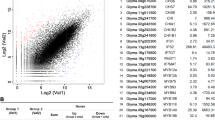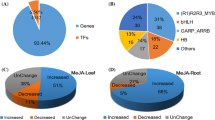Abstract
Key message
GmMYB58 and GmMYB205 are key positive regulators that are involved in isoflavonoid biosynthesis in seeds of Glycine max, and they activate the expression of several structural genes in the isoflavonoid pathway.
Abstract
MYB transcription factors (TFs) are major regulators involved in flavonoid/isoflavonoid biosynthesis in many plant species. However, functions of most MYB TFs remain unknown in flavonoid/isoflavonoid pathway in Glycine max. In this study, we identified 321 MYB TFs by genome-wide searching, and further isolated and functionally characterized two MYB TFs, GmMYB58 and GmMYB205. The deduced GmMYB58 and GmMYB205 proteins contain highly conserved R2R3 repeat domain at the N-terminal region that is the signature motif of R2R3-type MYB TFs. GmMYB58 and GmMYB205 were highly expressed in early seed development stages than in the other tested organs. GmMYB58 and GmMYB205 GFP fusion proteins were found to be localized in the nucleus when they were transiently expressed in Arabidopsis thaliana mesophyll protoplast. Both GmMYB58 and GmMYB205 can activate the promoter activities of GmCHS, GmIFS2, and GmHID in the transient trans-activation assays, and the activation of GmHID by both GmMYB58 and GmMYB205 was further confirmed by yeast one-hybrid assay. In addition, over-expression of GmMYB58 and GmMYB205 resulted in significant increases in expression levels of several pathway genes in soybean hairy roots, in particular, IFS2 by more than fivefolds in GmMYB205-over-expressing lines. Moreover, isoflavonoid contents were remarkably enhanced in the GmMYB58 and GmMYB205 over-expressing hairy roots than in the control. Our results suggest that GmMYB58 and GmMYB205 are seed-specific TFs, and they can enhance isoflavonoid biosynthesis mainly through the regulation of GmIFS2 and GmHID in G. max.







Similar content being viewed by others
References
Akada S, Dube SK (1995) Organization of soybean chalcone synthase gene clusters and characterization of a new member of the family. Plant Mol Biol 29:189–199
Akashi T, Aoki T, Ayabe S (2005) Molecular and biochemical characterization of 2-hydroxyisoflavanone dehydratase. Involvement of carboxylesterase-like proteins in leguminous isoflavone biosynthesis. Plant Physiol 137:882–891
Asakura T, Tamura T, Terauchi K, Narikawa T, Yagasaki K, Ishimaru Y, Abe K (2012) Global gene expression profiles in developing soybean seeds. Plant Physiol Biochem 52:147–153
Austin MB, Noel AJP (2003) The chalcone synthase superfamily of type III polyketide synthases. Nat Prod Rep 20:79–110
Borevitz JO, Xia Y, Blount J, Dixon RA, Lamb C (2000) Activation tagging identifies a conserved MYB regulator of phenylpropanoid biosynthesis. Plant Cell 12:2383–2393
Cone KC, Burr FA, Burr B (1986) Molecular analysis of the maize anthocyanin regulatory locus C1. Proc Natl Acad Sci USA 83:9631–9635
Dhaubhadel S, McGarvey BD, Williams R, Gijzen M (2003) Isoflavonoid biosynthesis and accumulation in developing soybean seeds. Plant Mol Bio 53:733–743
Dhaubhadel S, Gijzen M, Moy P, Farhangkhoee M (2007) Transcriptome analysis reveals a critical role of CHS7 and CHS8 genes for isoflavonoid synthesis in soybean seeds. Plant Physiol 143:326–338
Di X, Yu L, Moore AB, Castro L, Zheng X, Hermon T, Dixon D (2008) A low concentration of genistein induces estrogen receptor-alpha and insulin-like growth factor-I receptor interactions and proliferation in uterine leiomyoma cells. Hum Reprod 23:1873–1883
Dixon RA (2004) Phytooestrogen. Annu Rev Plant Biol 55:25–261
Du H, Yang SS, Liang Z, Feng BR, Liu L, Huang YB, Tang YX (2012) Genome-wide analysis of the MYB transcription factor superfamily in soybean. BMC Plant Biol 12:106
Feng CY, Li SS, Yin DD, Zhang HJ, Tian DK, Wu Q, Wang LJ, Su S, Wang LS (2016) Rapid determination of flavonoids in plumules of sacred lotus cultivars and assessment of their antioxidant activities. Ind Crop Prod 87:96–104
Ferguson JB, Mathesius U (2003) Signaling interactions during nodule development. J Plant Growth Regul 22:47–72
Gonzalez A, Zhao M, Leavitt JM, Lloyd AM (2008) Regulation of the anthocyanin biosynthetic pathway by the TTG1/bHLH/Myb transcriptional complex in Arabidopsis seedlings. Plant J 53:814–827
Griffith AP, Collison MW (2001) Improved methods for the extraction and analysis of isoflavones from soy-containing foods and nutritional supplements by reversed-phase high-performance liquid chromatography and liquid chromatography-mass spectrometry. J Chromatogr A 913:397–413
Grotewold E, Sainz MB, Tagliani L, Hernandez JM, Bowen B, Chandler VL (2000) Identification of the residues in the Myb domain of maize C1 that specify the interaction with the bHLH cofactor R. Proc Natl Acad Sci USA 97:13579–13584
Hancock KR, Collette V, Fraser K, Greig M, Xue H, Richardson K, Jones C, Rasmussen S (2012) Expression of the R2R3-MYB transcription factor TaMYB14 from Trifolium arvense activates proanthocyanidin biosynthesis in the legumes Trifolium repens and Medicago sativa. Plant Physiol 159:1204–1220
Jeanmougin F, Thompson JD, Gouy M, Higgins DG, Gibson TJ (1998) Multiple sequence alignment with Clustal X. Trends Biochem Sci 23:403–405
Jiang W, Yin Q, Wu R, Zheng G, Liu J, Dixon RA, Pang Y (2015) Role of a chalcone isomerase-like protein in flavonoid biosynthesis in Arabidopsis thaliana. J Exp Bot 29:229–285
Jung W, Yu O, Lau SMC, O’Keefe DP, Odell J, Fader G, McGonigle B (2000) Identification and expression of isoflavone synthase, the key enzyme for biosynthesis of isoflavones in legumes. Nat Biotech 18:208–212
Kudou S, Fleury Y, Welti D, Magnolato D, Uchida T, Kitamura K, Okubo K (1991) Malonyl isoflavone glycosides in soybean seeds (Glycine max Merrill). Agric Biol Chem 55:2227–2233
Li XW, Li JW, Zhai Y, Zhao Y, Zhao X, Zhang HJ, Su LT, Wang Y, Wang QY (2013) A R2R3-MYB transcription factor, GmMYB12B2, affects the expression levels of flavonoid biosynthesis genes encoding key enzymes in transgenic Arabidopsis plants. Gene 532:72–79
Lin R, Ding L, Casola C, Ripoll DR, Feschotte C, Wang H (2007) Transposase-derived transcription factors regulate light signaling in Arabidopsis. Science 318:1302–1305
Liu X, Yuan L, Xu L, Xu Z, Huang Y, He X, Ma H, Yi J, Zhang D (2013) Over-expression of GmMYB39 leads to an inhibition of the isoflavonoid biosynthesis in soybean (Glycine max. L). Plant Biotech Rep 7:445–455
Lozovaya VV, Lygin AV, Zernova OV, Li SX, Hartman GL, Widholm JM (2004) Isoflavonoid accumulation in soybean hairy roots upon treatment with Fusarium solani. Plant Physiol Biochem 42:671–679
Matus JT, Aquea F, Arce-Johnson P (2008) Analysis of the grape MYB R2R3 subfamily reveals expanded wine quality-related clades and conserved gene structure organization across Vitis and Arabidopsis genomes. BMC Plant Biol 8:83
Moore AB, Castro L, Yu L, Zheng X, Di X, Sifre MI, Kissling GE, Newbold RR, Bortner CD, Dixon D (2007) Stimulatory and inhibitory effects of genistein on human uterine leiomyoma cell proliferation are influenced by the concentration. Hum Reprod 22:2623–2631
Nesi N, Jond C, Debeaujon I, Caboche M, Lepiniec L (2001) The Arabidopsis TT2 gene encodes and R2R3 MYB domain protein that acts as a key determinant for proanthocyanidin accumulation in developing seed. Plant Cell 13:2099–2114
Peel GJ, Pang Y, Modolo LV, Dixon RA (2009) The LAP1 MYB transcription factor orchestrates anthocyanidin biosynthesis and glycosylation in Medicago. Plant J 59:136–149
Prouse MB, Campbell MM (2012) The interaction between MYB proteins and their target DNA binding sites. Biochim Biophys Acta 1819:67–77
Ralston L, Subramanian S, Matsuno M, Yu O (2005) Partial reconstruction of flavonoid and isoflavonoid biosynthesis in yeast using soybean type I and type II chalcone isomerases. Plant Physiol 137:1375–1388
Romero Fuertes, Benito Malpica, Leyva Paz-Ares (1998) More than 80 R2R3-MYB regulatory genes in the genome of Arabidopsis thaliana. Plant J 14:273–284
Sainz MB, Grotewold E, Chandler VL (1997) Evidence for direct activation of an anthocyanin promoter by the maize C1 protein and comparison of DNA binding by related Myb domain proteins. Plant Cell 9:611–625
Sarkar FH, Li YW (2003) Soy isoflavones and cancer prevention. Cancer Invest 21:744–757
Sheen J (2002) A transient expression assay using Arabidopsis mesophyll protoplasts. http://genetics.mgh.harvard.edu/sheenweb/
Steele CL, Gijzen M, Qutob D, Dixon RA (1999) Molecular characterization of the enzyme catalyzing the aryl migration reaction of isoflavonoid biosynthesis in soybean. Arch Biochem Biophys 367:146–150
Stracke R, Werber M, Weisshaar B (2001) The R2R3-MYB gene family in Arabidopsis thaliana. Curr Opin Plant Biol 4:447–456
Subramanian S, Graham MY, Yu O, Graham TL (2005) RNA interference of soybean isoflavone synthase genes leads to silencing in tissues distal to the transformation site and to enhanced susceptibility to Phytophthora sojae. Plant Physiol 137:1345–1353
Subramanian S, Stacey G, Yu O (2006) Endogenous isoflavones are essential for the establishment of symbiosis between soybean and Bradyrhizobium japonicum. Plant J 48:261–273
Tamura K, Dudley J, Nei M, Kumar S (2007) MEGA4: molecular evolutionary genetics analysis (MEGA) software version 4.0. Mol Biol Evol 24:1596–1599
Terrier N, Torregrosa L, Ageorges A, Vialet S, Verriès C, Cheynier V, Romieu C (2009) Ectopic expression of VvMybPA2 promotes proanthocyanidin biosynthesis in grapevine and suggests additional targets in the pathway. Plant Physiol 149:1028–1041
Watanabe S, Uesugi S, Kikuchi Y (2002) Isoflavones for prevention of cancer, cardiovascular diseases, gynecological problems and possible immune potentiation. Biomed Pharmacother 56:302–312
White LJ, Jothibasu K, Reese RN, Broezel VS, Subramanian S (2015) Spatio temporal influence of isoflavonoids on bacterial diversity in the soybean rhizosphere. Mol Plant Microbe In 28:22–29
Wilkins O, Nahal H, Foong J, Provart NJ, Campbell MM (2009) Expansion and diversification of the Populus R2R3-MYB family of transcription factors. Plant Physiol 149:981–993
Yan J, Wang B, Zhong Y, Yao L, Cheng L, Wu T (2015) The soybean R2R3 MYB transcription factor GmMYB100 negatively regulates plant flavonoid biosynthesis. Plant Mol Biol 89:35–48
Yi J, Derynck MR, Li X, Telmer P, Marsolais F, Dhaubhadel S (2010) A single-repeat MYB transcription factor, GmMYB176, regulates CHS8 gene expression and affects isoflavonoid biosynthesis in soybean. Plant J 62:1019–1034
Yoshida K, Iwasaka R, Kaneko T, Sato S, Tabata S, Sakuta M (2008) Functional differentiation of Lotus japonicus TT2s, R2R3-MYB transcription factors comprising a multigene family. Plant Cell Physiol 49:157–169
Zhao Q, Wang HZ, Yin YB, Xu Y, Chen F, Dixon RA (2010) Syringyl lignin biosynthesis is directly regulated by a secondary cell wall master switch. Proc Natl Acad Sci USA 107:14496–14501
Zhu Z, Wang H, Wang Y, Guan S, Wang F, Tang J, Zhang R, Xie L, Lu Y (2015) Characterization of the cis elements in the proximal promoter regions of the anthocyanin pathway genes reveals a common regulatory logic that governs pathway regulation. J Exp Bot 66:3775–3789
Zimmermann IM, Heim MA, Weisshaar B, Uhrig JF (2004) Comprehensive identification of Arabidopsis thaliana MYB transcription factors interacting with R/B-like BHLH proteins. Plant J 40:22–34
Acknowledgements
This work was supported by the National Key Research and Development Program of China (2016YFD0101005), Major State Basic Research and Development Program of China (2013CB127002), and the National Natural Science Foundation of China (31670305). We thank Ms. Yan Zhu for kind assistance with LC–MS and Mr. Guangshun Zhen for assistance in hairy root generation.
Author information
Authors and Affiliations
Corresponding author
Ethics declarations
Conflict of interest
The authors declare that they have no conflict of interest.
Additional information
Communicated by Qiao Zhao.
Electronic supplementary material
Below is the link to the electronic supplementary material.
Rights and permissions
About this article
Cite this article
Han, X., Yin, Q., Liu, J. et al. GmMYB58 and GmMYB205 are seed-specific activators for isoflavonoid biosynthesis in Glycine max . Plant Cell Rep 36, 1889–1902 (2017). https://doi.org/10.1007/s00299-017-2203-3
Received:
Accepted:
Published:
Issue Date:
DOI: https://doi.org/10.1007/s00299-017-2203-3




